Container marine market: extended peak season to fuel sea freight
The rapid spread of Delta Variant worldwide exacerbated the incontrollable container marine market. The freight rate of US route has breached US$20,000. Peak season of the market is likely to continue into the fourth quarter of 2021. A number of shipping companies have announced various surcharges.
Container marine market is during peak season now. Impacted by the spread of Delta Variant in China, the freight rate of the E/C America Service has surged to US$20,000/FEU from $11,000/FEU in late-Jul, which was 5 times of that during the same period of last year. The freight rate of the W/C America Service was also near US$20,000/FEU. With soaring freight rate of the America route, consolidators successively put shipping capability to major Asia-North America routes.
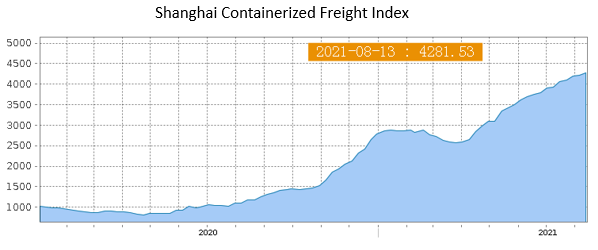
Source: Shanghai Shipping Exchange
The demand on container marine market remained high in China, and the freight of most routes remained largely flat this week. According to the data from Shanghai Shipping Exchange, the Shanghai containerized freight index was at 4281.53 on Aug 13.
European route:
With worse spread of the Delta Variant in Europe, new infections rebounded in many nations and stricter regulation was seen. According to latest data, the manufacturing PMI was at 62.8 in Jul in the Eurozone, better than anticipated and indicating better economic recovery. Transportation demand sustained high. Some ports still witnessed congestion and the overall shipping capability remained tight. The average utilization rate of seats at Shanghai port was still near 100%.
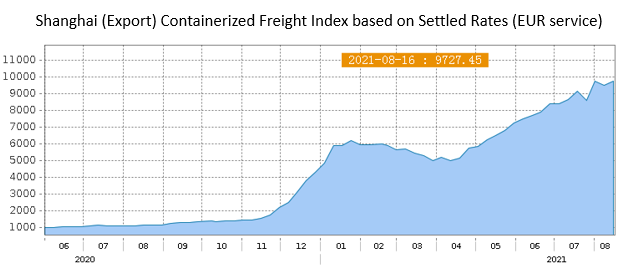
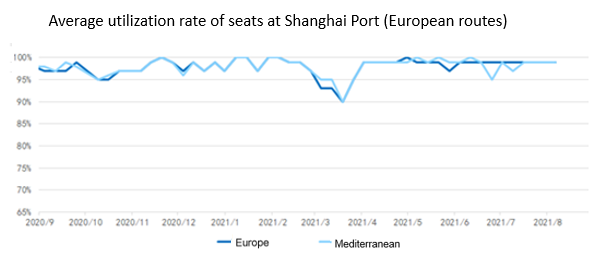
Source: Shanghai Shipping Exchange
On Aug 13, the freight rate from Shanghai to basic ports in Europe was at $7,407/TEU. As for the Mediterranean route, transportation demand held flat and the average utilization rate of seats at Shanghai port was around 100%. On Aug 13, the freight rate from Shanghai to basic ports in Mediterranean was at $7,051/TEU.
North America route:
The non-farm employment data performed well in Jul in US, far hitting expectation. However, the recovery tempo of economy in US needed further observation with the spread of the Delta Variant. Demand for pandemic prevention materials and daily necessities sustained high. Aug was traditional peak season on transportation market but the handling efficiency of ports sharply reduced in US. The stagnated of containers, unsmooth transportation and the congestion at ports maintained. The average utilization rate of seats in W/C America Service and E/C America Service was still near 100% at Shanghai port. The sea freight was steady this week.
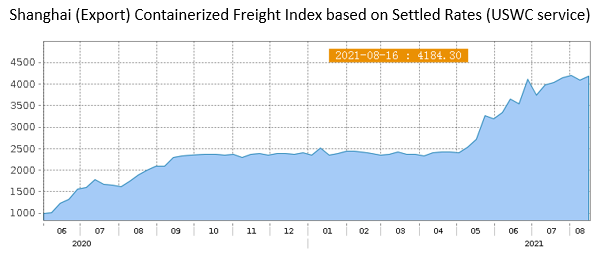
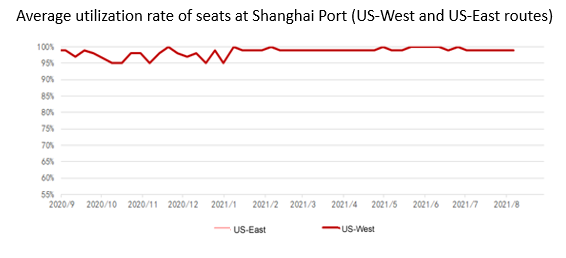
Source: Shanghai Shipping Exchange
China's Ningbo saw one new confirmed COVID-19 case, who worked in Ningbo Meidong Container Terminal Co., Ltd. The relevant places have been suspended and sterilization and disinfection has been made. Meishan port, which is one of the newest and biggest ports in Ningbo, has suspended operation, while the work of other ports has not been impacted temporarily. Actually, Shanghai and Ningbo ports have been seriously congested since last month affected by the typhoon. Some delay may appear after the nucleic acid testing of workers at ports increased and the change of crew. It was reported that 140 container ships were waiting in the external anchorage of the two ports
One insider expressed that if Ningbo port or one of the 6 major ports is closed or their production capability diminishes, it may have a long-term effect like the Yantian port. The carrier will need to decide whether they will omit the ports to maintain the reliability of existing boat or caught in unavoidable queuing and congestion
The phenomenon of congestion and delay appeared again in the United States West Coast port. Container ship mooring at anchorage reached 19 and ships waiting for the anchor outside the ports were 11. The delay increased from 5.4 days to 5.8 days.
Increasing shipping capability mainly came from Asia, Middle East, India, Africa and the Atlantic line, while these routes also faced inadequate shipping capability as a result. The freight rate from North Europe to the east coast of the United States surged to $6,000/FEU from $2,000/FEU since Mar and shippers also needed to pay additional cost. Some insider pointed out that the pandemic has been very serious in US. Some enterprises are supposed to resume work in Sep according to their earlier schedule, but it may be delayed. As a result, the earlier estimated revenge consumption may be postponed and the peak season of the container marine market may be delayed into the fourth quarter.
In addition, with intensified pandemic in Southeast Asia and China, sales volume declined and the delivery was delayed in Vietnam as many factories were forced to shut down temporarily. Factories in China witnessed stable operation now but the situation has escalated. The movement of the Delta Variant needs further observation. Some analysts expressed that orders remained and import demand sustained high, but the shipping time was extended, which may result into slightly mitigated tight containers and shipping space. The delivery of some cargos may be extended into the Q4.
The spread of pandemic escalated in US impacted by the Delta Variant. As a consequence, consumers showed sharply falling confidence. The retail sales increased in Jun but it was mainly stimulated by higher price. Falling actual expenditure may be a signal for slower growth in the second half of year. However, some experts said that participants still needed to replenish with historic low inventory despite of slower demand improvement. The freight rate is expected to continue rising in short run. Supply may be hard to be mitigated greatly before the new boats being launched in 2023. As for the freight rate of containers in long run, it is hard to recover to the pre-pandemic level.
- Top keywords
- Cotton Price
- Cotton Futures Price
- Cotton Futures
- CZCE
- PTA Futures Price
- Chemical Fiber
- Polyester Prices
- Wool price
- PTA Futures
- Shengze Silk
- China
- Yarn Price
- price
- China Textile City
- Fibre Price
- Benzene Price
- Cotton
- Index
- Cotton Index
- PTA
- fabric price
- NYMEX
- Top 10
- textile industry
- Spot Cotton
- Cotton Yarn
- Polyester Price
- Futures
- PTA Price
- cotton yarn price

